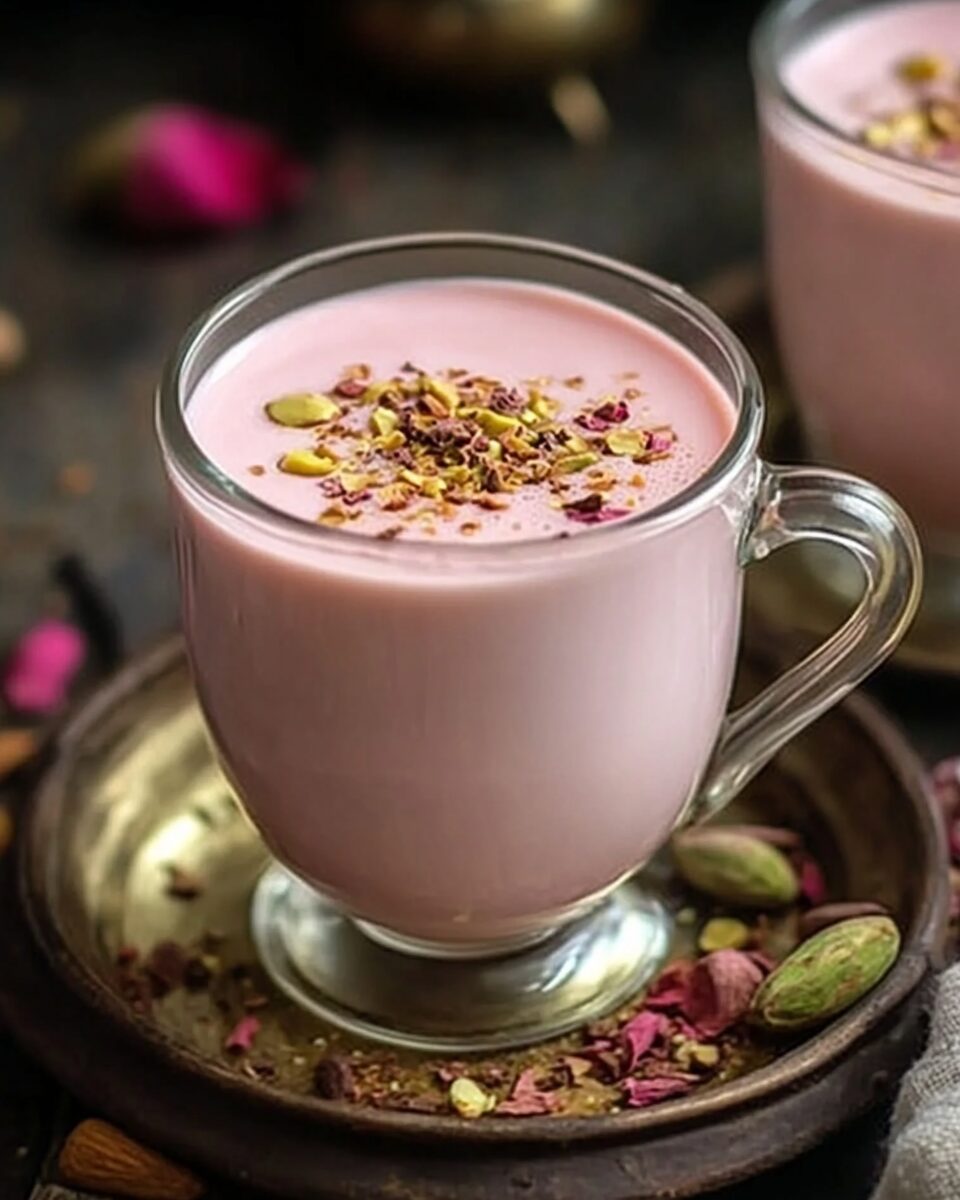The iconic Kashmiri Pink Chai, also known as Noon Chai, is more than just a warm beverage it’s a cultural experience steeped in tradition and history. Originating from the snow-clad valleys of Kashmir, this vibrant tea is cherished not only for its eye-catching rosy hue but also for its unique blend of salty and sweet, creamy and spiced flavors. Crafted with green tea leaves, baking soda, milk, and aromatic spices like cardamom and cinnamon, this chai gets its distinct pink color through a fascinating chemical reaction during the brewing process. Often served at weddings, festive occasions, or cozy winter evenings, it’s a drink that warms the body and soul. Top it with crushed pistachios and a sprinkle of rose petals for an elevated finish that reflects its rich heritage.
Full Recipe:
Ingredients:
-
4 cups water
-
2 teaspoons green tea leaves (preferably Kashmiri or Chinese gunpowder)
-
1/4 teaspoon baking soda
-
1/4 teaspoon salt
-
2 cups cold water
-
2 cups whole milk
-
1/4 teaspoon ground cardamom
-
1/4 teaspoon ground cinnamon
-
2 tablespoons crushed pistachios
-
Sugar to taste
-
Optional: slivered almonds, rose petals for garnish
Directions:
-
In a heavy saucepan, bring 4 cups of water to a boil. Add green tea leaves and baking soda. Simmer on low heat for 15–20 minutes, stirring occasionally.
-
As the tea simmers, the color will intensify. Add salt and whisk vigorously for 5 minutes to aerate the tea and develop the signature pink hue.
-
Slowly add the cold water and continue whisking. Then pour in the milk, and simmer for another 10 minutes on low heat.
-
Add cardamom and cinnamon, and sweeten to taste with sugar.
-
Strain the tea into cups, and top with crushed pistachios, almonds, or rose petals for garnish if desired. Serve hot.
Prep Time: 5 minutes | Cooking Time: 30 minutes | Total Time: 35 minutes
Kcal: 160 kcal | Servings: 4 servings
The Rich Legacy and Delicate Beauty of Kashmiri Pink Chai (Noon Chai)
Kashmiri Pink Chai, also known locally as Noon Chai or Gulabi Chai, is more than just a warm beverage it is an emblem of tradition, culture, and hospitality rooted in the heart of Kashmir. With its signature blush-pink color, creamy texture, and a subtle balance of salty and sweet, this unique tea captivates both the senses and the imagination. Unlike most teas, Noon Chai is not just consumed for caffeine it’s savored for ceremony, comfort, and connection. In this article, we will dive deep into the story behind this beautiful brew, its cultural significance, preparation secrets, serving suggestions, health benefits, and why it’s gaining global appreciation today.
The Origins and Cultural Significance of Kashmiri Pink Chai
Noon Chai originates from the cold, mountainous valleys of Kashmir, a region nestled between India and Pakistan. The word Noon in several South Asian languages means “salt,” which already hints at one of the most unique aspects of this tea it is traditionally made with a pinch of salt instead of sugar. Over the centuries, as cultures blended and recipes evolved, modern interpretations often incorporate both salt and sugar, making it more palatable to a broader audience.
In Kashmiri households, Pink Chai is much more than a drink it’s a ritual that embodies warmth, elegance, and communal bonding. It’s traditionally served in ornate samovars (large metal tea urns) during winter mornings, wedding ceremonies, family gatherings, and religious festivities. A steaming cup of Noon Chai is usually accompanied by traditional breads like kulcha or bakharkhani, and its preparation is considered an act of love and hospitality.
What Makes Noon Chai Pink?
One of the most fascinating aspects of Kashmiri Pink Chai is its color transformation from a deep green brew to a stunning blush-pink finish. This transformation is the result of a delicate chemical reaction that occurs during the brewing process. It starts with green tea leaves (often gunpowder tea), which are simmered for a long period with baking soda. The soda interacts with the chlorophyll in the tea leaves and changes the pH level, which allows the color to develop once milk is added.
It’s a process that requires patience, technique, and even a bit of finesse. The tea must be whisked vigorously at just the right moments to incorporate air, enhance the color, and develop the creamy texture. Achieving the perfect hue of pink is considered a matter of pride among skilled home cooks and chai wallahs (tea vendors) across Kashmir.
Flavor Profile: A Symphony of Subtlety
Unlike spiced teas like masala chai, which are bold and fiery, Noon Chai is delicate, layered, and soothing. Its salty-sweet balance is unlike any other tea. The base notes are nutty and slightly earthy from the green tea, while baking soda adds a mild bitterness that gets mellowed by milk. Aromatic spices like cardamom and cinnamon introduce a gentle warmth, and optional garnishes like crushed pistachios or slivered almonds provide texture and a nutty finish.
The salt in the traditional version isn’t merely for taste it plays a critical role in balancing the flavors and also helps warm the body, making it especially comforting during cold weather.
Rituals of Serving and Enjoyment
Serving Noon Chai is an experience in itself. It is typically poured into small, decorative cups, sometimes topped with crushed nuts or dried rose petals for an added touch of luxury. It’s not uncommon to enjoy it alongside savory pastries or flaky Kashmiri breads, which contrast beautifully with the creamy, warming drink.
In Kashmiri weddings, Noon Chai is served to guests throughout the day, often in between rich meals or as a welcoming gesture. In some homes, especially during winter months, families gather around a traditional kangri (a clay pot heater) and sip on pink chai while sharing stories and laughter.
Health Benefits of Kashmiri Pink Chai
Although indulgent and comforting, Kashmiri Pink Chai also offers some surprising health benefits:
-
Antioxidants: The green tea base is rich in polyphenols and antioxidants, which help reduce inflammation and support overall health.
-
Digestive Aid: The baking soda can aid digestion and help soothe the stomach.
-
Cardiovascular Health: Cardamom and cinnamon are known to support heart health, regulate blood sugar, and improve circulation.
-
Mood Enhancement: The warm, aromatic drink can be calming and may help relieve stress, thanks to its soothing spices and comforting nature.
Despite its richness, the tea is often made without added sweeteners, making it a lower-sugar alternative to many modern milk teas and lattes.
A Global Embrace of a Regional Treasure
In recent years, Kashmiri Pink Chai has found its way beyond the valleys of Kashmir and into cafes, social media feeds, and home kitchens around the world. Its aesthetic appeal creamy, pastel pink with green and white nut toppings makes it a favorite among food stylists and tea lovers alike. On platforms like Instagram and TikTok, pink chai videos have gone viral for their visual beauty and “magical” transformation process.
Many cafes are now offering pink chai as a premium alternative to regular tea or coffee, sometimes infused with rose, saffron, or even beetroot for an enhanced color. While some of these modern variations stray far from tradition, they help preserve the essence of Kashmiri Noon Chai and introduce it to newer generations in a fun, creative way.
Advertisement
Tips for Perfecting Your Own Pink Chai at Home
If you’re preparing this drink at home, here are a few expert tips to ensure a beautiful, authentic result:
-
Use quality tea: Look for green tea with whole leaves or gunpowder tea, which holds up well to long simmering.
-
Patience is key: Simmer the tea base slowly, and whisk often to allow full oxygenation this helps develop the signature pink color.
-
Don’t rush the color: The pink hue won’t appear until milk is added don’t be discouraged if the brew initially looks murky.
-
Use full-fat milk: It enhances the creaminess and balances the earthy tones of the tea.
-
Garnish generously: Pistachios, almonds, and rose petals not only enhance the taste but also make for a beautiful presentation.
Conclusion:
Kashmiri Pink Chai is a recipe deeply steeped in history, tradition, and cultural pride. It’s a drink that invites patience, precision, and passion. From the art of brewing to the ritual of serving, every cup tells a story of the majestic Kashmir region of its people, its climate, and its warmth.
Whether you’re a tea enthusiast, a lover of global cuisine, or simply someone who enjoys a comforting cup of something special, Pink Chai is an experience worth savoring. It’s an invitation to slow down, connect, and delight in the finer things a blend of tradition and taste in every single sip.

